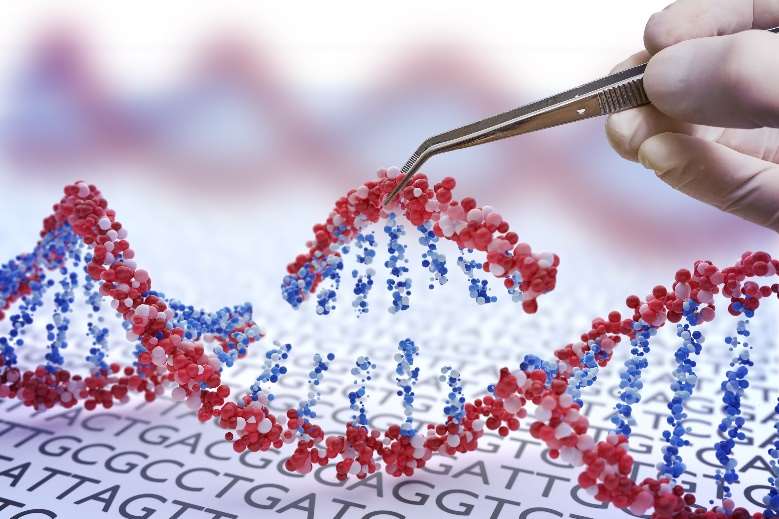Probes are artificially synthesized short sequences of DNA or RNA that can be labeled with radioactive or nonradioactive molecules. They can have a length of 100 to 1000 bases. Probes are useful in detecting target nucleotide sequences that are complementary to the probe sequence.
In theory, any nucleic acid can be deployed as a probe, given it is labelled to allow recognition and quantitation of the hybrid molecules which form between the probe to be recognized and the probe. Broadly, probes can be classified into DNA probes and RNA probes. The main difference between DNA and RNA probes is that DNA probes are fragments of DNA that are complementary to the target nucleotide sequence, while RNA probes are extensions of single-stranded RNA complementary to that of the sequences of nucleic acids of the target sequences.

What are DNA Probes?
A DNA probe is a labeled fragment of DNA that contains a nucleotide sequence specific for the gene or chromosomal region of interest. A variety of methodologies for labeling DNA have been described.
Enzyme-mediated labeling techniques rely heavily on the activity of polymerases, which are responsible for the incorporation of labeled nucleotides. Additionally, the use of Taq or other thermostable DNA polymerases allows labeling reactions to be performed at higher temperatures via PCR, thereby reducing the incidence of enzyme-mediated point mutations during probe synthesis.
PCR is an excellent probe synthesis method that requires very small amounts of template material. PCR products are labeled as they are being synthesized in the presence of appropriately labeled nucleotide primers. Alternatively, the primers themselves can be labeled non-isotopically during their own synthesis, eliminating the need for labeled nucleotide precursors as part of the reaction mixture. Random priming is a type of primer extension in which a mixture of small oligonucleotide sequences, acting as primers, anneal to a heat-denatured double-stranded template. The annealed primers end up becoming part of the probe itself, because the Klenow fragment of DNA polymerase I extends the primers in the 3′ direction and incorporates the label in doing so.
Nick translation (NT) is one of the oldest probe labeling techniques. It involves randomly cleaving the backbone of double-stranded DNA with dilute DNase I. At very low concentrations, this enzyme cleaves the template at four or five sites, producing a free 3′-OH group that can act as a primer at each cleavage site. Next, DNA polymerase I removes the native nucleotides from the probe molecules along the 5′→3′ direction (exonuclease activity) while replacing them with labeled dNTP precursors by virtue of its 5′→3′ polymerase activity.
What are RNA Probes?
RNA probes are extensions of single-stranded RNA used to detect the presence of complementary nucleic acid sequences (target sequences) by hybridization. There is only one reliable method for labeling RNA probes, which is in vitro transcription.
By transcription of a DNA sequence linked next to an RNA promoter, a large number of efficiently labeled probes of uniform length can be generated. An excellent strategy is to clone the DNA to be transcribed between two promoters with opposite orientations. This allows either strand of the cloned DNA sequence to be transcribed to generate sense and antisense RNA for hybridization studies. Another way to generate continuously labeled RNA probes by in vitro transcription is to label the 5' end of the molecule. This method of 5' end-labeling is commonly known as kinase reaction. This reaction specifically involves the transfer of the γ phosphate of ATP to a 5'-OH substrate of RNA or DNA (forward reaction). The forward kinase reaction is much more efficient than the exchange reaction that involves the substitution of 5' phosphates. RNA can also be 3' end-labeled using poly(A) polymerase. This enzyme, which is naturally responsible for nuclear polyadenylation of many heteronuclear RNAs, catalyzes the incorporation of adenosine monophosphate.
What are the Differences Between DNA and RNA Probes?
The following table lists the important differences between DNA and RNA probes.
| DNA probes | RNA probes | |
| Definition | DNA probes are short DNA fragments complementary to the target sequences. | RNA probes are short single-stranded RNA extensions that are complementary to the target sequences. |
| Nucleotides | A, C, T and G | A, C, G and U |
| Function | Mainly by PCR amplification or cloning | Mainly by in vitro transcription of template DNA by an RNA polymerase |
| Thermodynamic stability | Comparatively lesser | Comparatively greater |
| Affinity towards the complementary sequences | High affinity | Tightly associates with its complementary sequence compared to the DNA probes |
What are the Uses of the Probes?
In Northern blotting, RNA is fractionated by gel electrophoresis. The molecules are then transferred to a membrane incubated with labeled probes. Hybridization of complementary sequences allows visualization of target RNA sequences. Southern blotting involves the fractionation and transfer of DNA to a membrane. The membrane is then incubated with labeled DNA probes. Hybridization of complementary sequences allows visualization of target DNA sequence.
CISH and FISH allow localization of RNA or DNA targets in cells and tissues. This technique uses cultured cells or tissue section samples for hybridization and detection of the gene or target sequences of interest. Cells or tissues are processed so that their endogenous nucleic acids are fixed but available for hybridization by labeled probes. Advances in spatial biology and single-cell analysis techniques are providing new insights into the phenotypic and functional heterogeneity within seemingly identical cell populations.